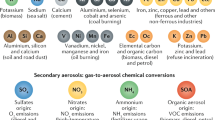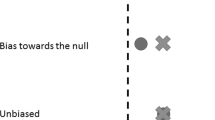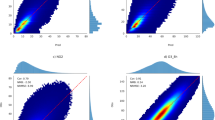Abstract
The Clean Air Act mandates that the US Environmental Protection Agency (EPA) develop National Ambient Air Quality Standards for criteria air pollutants and conduct periodic reviews of the standards based on new scientific evidence. In recent reviews, evidence from epidemiologic studies has played a key role. Epidemiologic studies often provide evidence for effects of several air pollutants. Determining whether there are independent effects of the separate pollutants is a challenge. Among the many issues confronting the interpretation of epidemiologic studies of multi-pollutant exposures and health effects are those specifically related to statistical modeling. The EPA convened a workshop on 13 and 14 December 2006 in Chapel Hill, North Carolina, USA, to discuss these and other issues; Session Three of the workshop was devoted specifically to statistical modeling. Prominent statistical modeling issues in epidemiologic studies of air pollution include (1) measurement error across the co-pollutants; (2) correlation and multi-collinearity among the co-pollutants; (3) the timing of the concentration–response function; (4) confounding; and (5) spatial analyses.
The views expressed in this paper are those of the authors and do not necessarily reflect the views of policies of the US Environmental Protection Agency.
This is a preview of subscription content, access via your institution
Access options
Subscribe to this journal
Receive 6 print issues and online access
$259.00 per year
only $43.17 per issue
Buy this article
- Purchase on Springer Link
- Instant access to full article PDF
Prices may be subject to local taxes which are calculated during checkout
Similar content being viewed by others
References
Adar S.D., Gold D.R., Coull B.A., Schwartz J., Stone P.H., and Suh H. Focused exposures to airborne traffic particles and heart rate variability in the elderly. Epidemiology 2007: 18: 95–103.
Akaike H. A new look at the statistical model identification. IEEE Trans Automatic Control 1974: 19: 716–723.
Almon S. The distributed lag between capital appropriations and expenditures. Econometrica 1965: 33: 178–196.
Beckerman B., Jerrett M., Brook J., Arain M., Verma D., and Finkelstein M. Correlation parameters of NO2 to other traffic pollutants near a major expressway. Atmos Environ (in press).
Bell M.L., McDermott A., Zeger S.L., Samet J.M., and Dominici F. Ozone and short-term mortality in 95 US urban communities, 1987–2000. JAMA 2004: 292: 2372–2378.
Brandt S., and Hanemann M. Valuing reduced asthma morbidity in children. Presented at EPA Workshop of Valuation of Children's Health, October 20–21 2003: (http://es.epa.gov/ncer/publications/workshop/pdf/EE-0475-07.pdf).
Bresnahan B.W., Dickie M., and Gerking S. Averting behavior and urban air pollution. Land Econ 1997: 73: 340–357.
Burnett R.T., Brook J., Dann T., Delocla C., Philips O., and Cakmak S., et al. Association between particulate- and gas-phase components of urban air pollution and daily mortality in eight Canadian cities. Inhal Toxicol 2000: 12: 15–39.
Cendon S., Pereira L.A., Braga A.L., Conceicao G.M., Cury Junior A., and Romaldini H., et al. Air pollution effects on myocardial infarction. Rev Saude Publica 2006: 40: 414–419.
Chen S., Shogren J.F., Orazem P.F., and Crocker T.D. Prices and health: identifying the effects of nutrition, exercise, and medication choices on blood pressure. Am J Agric Econ 2002: 84: 990–1002.
Clyde M. Model uncertainty and health effect studies for particulate matter. Environmetrics 2000: 11: 745–763.
Environmental Protection Agency. Air Quality Criteria for Ozone and Related Photochemical Oxidants (Final). US Environmental Protection Agency, Washington, DC, EPA/600/R-05/004aF-cF 2006.
Environmental Protection Agency. Air Quality Criteria for Particulate Matter. Research Triangle Park, NC, National Center for Environmental Assessment-RTP Office, Report no. EPA/600/P-99/002aD 2004.
Fung K.Y., Khan S., Krewski D., and Chen Y. Association between air pollution and multiple respiratory hospitalizations among the elderly in Vancouver, Canada. Inhal Toxicol 2006: 18: 1005–1011.
Gauderman W.J., Gilliland G.F., Vora H., Avol E., Stram D., and McConnel R., et al. Association between air pollution and lung function growth in southern California children. Am J Resp Crit Care Med 2002: 166: 76–84.
Gold D.R., Damokosh A.I., Pope III C.A., Dockery D.W., McConnell W.F., and Serrano P., et al. Particulate and ozone pollutant effects on the respiratory function of children in Southwest Mexico City. Epidemiology 1999: 10: 8–16.
Health Effects Institute. Commentary on revised analyses of selected studies. In: Revised Analyses of Time-Series Studies of Air Pollution and Health, Special report Boston, MA, Health Effects Institute, 2003 pp. 255–290 Available: http://www.healtheffects.org/Pubs/TimeSeries.pdf(18 October 2004).
Ito K., Thurston G.D., and Silverman R.A. Characterization of PM2.5, gaseous pollutants, and meteorological interactions in the context of time-series health effects models. J Expo Sci Environ Epidemiol, 2007 (Suppl 2): S45–S60.
Jerrett M., Burnett R.T., Goldberg M.S., Sears M., Krewski D., and Catalan R., et al. Spatial analysis for environmental health research: concepts, methods, and examples. J Toxicol Environ Health A 2003: 66: 1783–1810.
Jerrett M., and Finkelstein M. Geographies of risk in studies linking chronic air pollution exposure to health outcomes. J Toxicol Environ Health A 2005: 68: 1207–1242.
Jerrett M., Newbold K.B., Burnett R.T., Thurston G., Lall R., and Pope III C.A., et al. Geographies of uncertainty in the health benefits of air quality improvements. Stoch Environ Res Risk Assess 2007: 21: 511–522.
Koop L., and Tole L. Measuring the health effects of air pollution: to what extent can we really say that people are dying from bad air? J Environ Econ Mgmt 2004: 47: 30–54.
Krewski D., Burnett R.T., Goldberg M.S., Hoover K., Siemiatycki J., Abrahamowicz M., and White W.H., et al. Reanalysis of the Harvard Six Cities Study and the American Cancer Society Study of Particulate Air Pollution and Mortality, Health Effects Institute Special Report. Health Effects Institute, Boston, (2000).
Laden F., Schwartz J., Speizer F.E., and Dockery D.W. Reduction in fine particulate air pollution and mortality: extended follow-up of the Harvard six cities study. Am J Respir Crit Care Med 2006: 173: 667–672.
Lee S.L., Wong W.H., and Lau Y.L. Association between air pollution and asthma admission among children in Hong Kong. Clin Exp Allergy 2006: 36: 1138–1146.
MacLehose R.F., Dunson D.B., Herring A.H., and Hoppin J.A. Bayesian methods for highly correlated exposure data. Epidemiology 2007: 18: 199–207.
Molitor J., Jerrett M., Chang C.C., Molitor N.T., Gauderman J., and Berhane K., et al. Assessing uncertainty in spatial exposure models for air pollution health effects assessment. Environ Health Perspect 2007: 115: 1147–1153.
Molitor J., Molitor N.T., Jerrett M., McConnell R., Gauderman J., Berhane K., and Thomas D. Bayesian modeling of air pollution health effects with missing exposure data. Am J Epidemiol 2006: 164: 69–76.
Neidell M. Air pollution, health, and socio-economic status: the effect of outdoor air quality on asthma exacerbation in children. J Health Econ 2004: 23: 1209–1236.
Neidell M. Public Information and Avoidance Behavior: Do People Respond to Smog Alerts?, Working Paper, October 2006: http://www.columbia.edu/~mn2191/abid_neidell.pdf.
O’Neill M.S., Zanobetti A., and Schwartz J. Modifiers of the temperature and mortality association in seven US cities. Am J Epidemiol 2003: 157: 1074–1082.
Peng R.D., Dominici F., Pastor-Barriuso R., Zeger S.L., and Samet J.M. Seasonal analyses of air pollution and mortality in 100 US cities. Am J Epidemiol 2005: 161: 585–594.
Pope III C.A., Burnett R.T., Thun M.J., Calle E.E., Krewski D., Ito K., and Thurston G.D. Lung cancer, cardiopulmonary mortality, and long-term exposure to fine particulate air pollution. JAMA 2002: 287: 1132–1141.
Schwartz J., and Coull B. Control for confounding in the presence of measurement error in hierarchical models. Biostatistics 2003: 4: 569–582.
Schwarz G. Estimating the dimension of a model. Ann Stat 1978: 6: 461–464.
Thomas D.C., Jerrett M., Kuenzli N., Louis T.A., Dominici F., and Zeger S., et al. Bayesian model averaging in time-series studies of air pollution and mortality. J Toxicol Environ Health A 2007a: 70: 311–315.
Thomas D.C., Stram D., and Dwyer J. Exposure measurement error: influence on exposure — disease relationships and methods of correction. Ann Rev Publ Health 1993: 14: 69–93.
Thomas D.C., Witte J.S., and Greenland S. Dissecting effects of complex mixtures: who's afraid of informative priors? Epidemiology 2007b: 18: 186–190.
Vedal S., Brauer M., White R., and Petkau J. Air pollution and daily mortality in a city with low levels of pollution. Environ Health Perspect 2003: 111: 45–51.
Willis A., Krewski D., Jerrett M., and Goldberg M. Selection of ecologic covariates in the American. Cancer Society Study. J Toxicol Environ Health 2003: 66: 1559–1586.
Wilson A.M., Wake C.P., Kelley T., and Salloway J.C. Air pollution, weather, and respiratory emergency room visits in two northern New England cities: an ecological time-series study. Environ Res 2005: 97: 312–321.
Witte J.S., Greenland S., Haile R.W., and Bird C.L. Hierarchical regression analysis applied to a study of multiple dietary exposures and breast cancer. Epidemiology 1994: 5: 612–621.
Zeger S.L., Thomas D., Dominici F., Samet J.M., Schwartz J., Dockery D., and Cohen A. Exposure measurement error in time-series studies of air pollution: concepts and consequences. Environ Health Perspect 2000: 108: 419–426.
Zhu Y., Hinds W.C., Kim S., and Sioutas C. Concentration and size distribution of ultrafine particles near a major highway. J Air Waste Manag Assoc 2002a: 52: 1032–1042.
Zhu Y., Hinds W.C., Kim S., Shen S., and Sioutas C. Study on ultrafine particles and other vehicular pollutants near a busy highway. Atmos Environ 2002b: 36: 4375–4383.
Author information
Authors and Affiliations
Corresponding author
Rights and permissions
About this article
Cite this article
Bateson, T., Coull, B., Hubbell, B. et al. Panel discussion review: session three — issues involved in interpretation of epidemiologic analyses — statistical modeling. J Expo Sci Environ Epidemiol 17 (Suppl 2), S90–S96 (2007). https://doi.org/10.1038/sj.jes.7500631
Received:
Accepted:
Published:
Issue Date:
DOI: https://doi.org/10.1038/sj.jes.7500631
Keywords
This article is cited by
-
Weather effects on hand, foot, and mouth disease at individual level: a case-crossover study
BMC Infectious Diseases (2019)
-
A simulation study to quantify the impacts of exposure measurement error on air pollution health risk estimates in copollutant time-series models
Environmental Health (2016)
-
The association of long-term exposure to PM2.5 on all-cause mortality in the Nurses’ Health Study and the impact of measurement-error correction
Environmental Health (2015)
-
Using community level strategies to reduce asthma attacks triggered by outdoor air pollution: a case crossover analysis
Environmental Health (2014)
-
Exposure measurement error in PM2.5 health effects studies: A pooled analysis of eight personal exposure validation studies
Environmental Health (2014)



